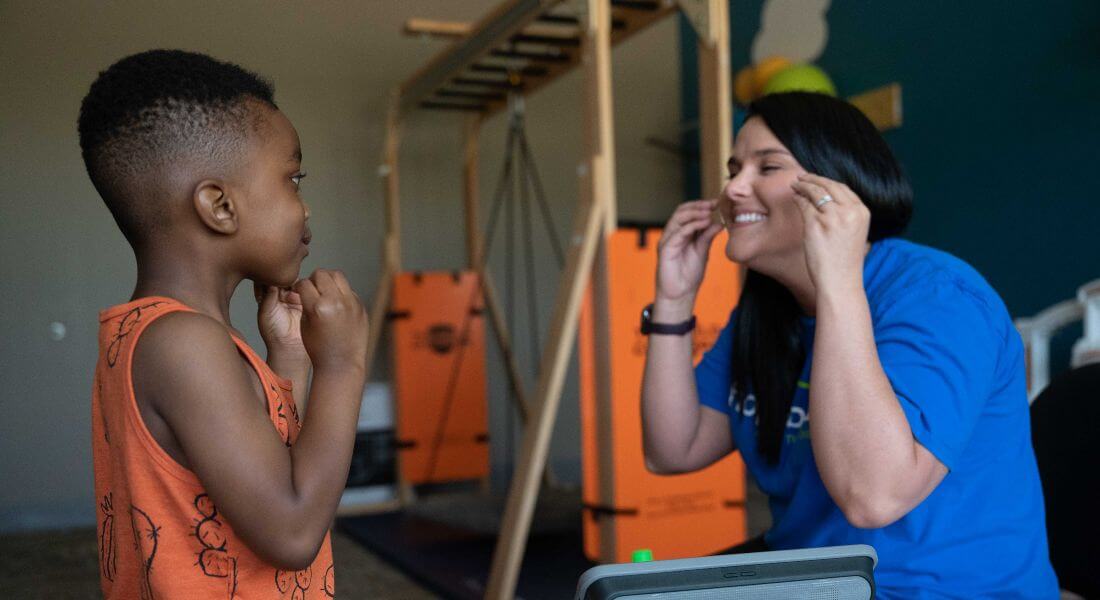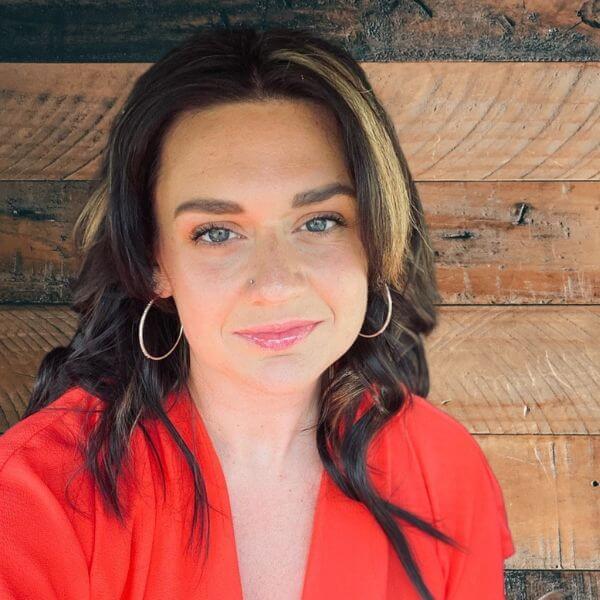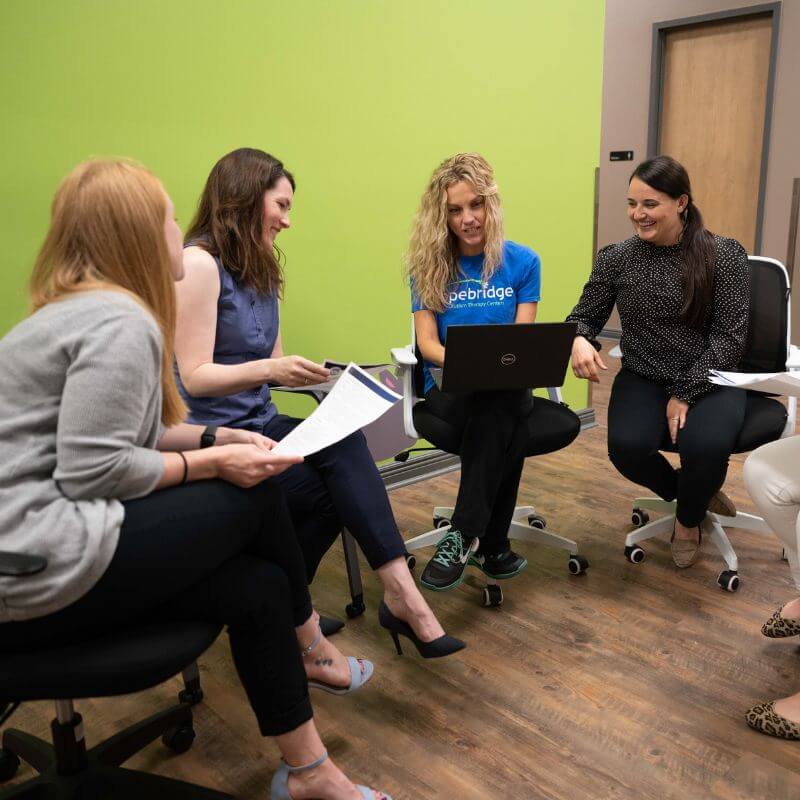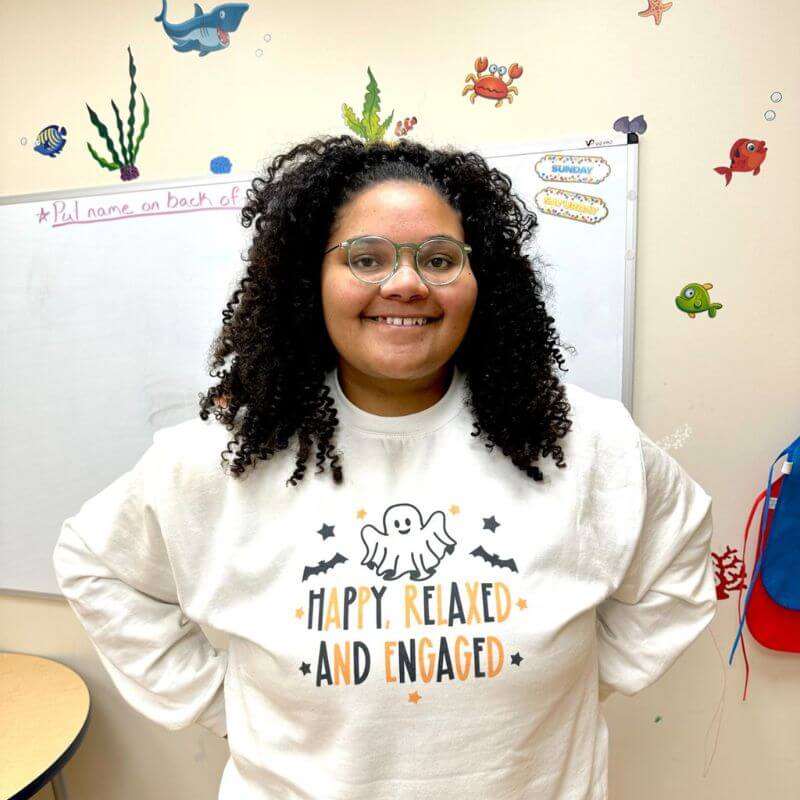Implementing HRE Within ABA Therapy
November 03, 2022
November 03, 2022

All children deserve the chance to be happy while being themselves. At Hopebridge, we aim to help children with autism harness their unique strengths and interests, as well as create opportunities for them to build onto their skillsets—all while honoring who they are as individuals.
This personalized, compassionate care is nothing new in our centers, but our clinical team continues to evolve our applied behavior analysis practice to enhance therapy through new concepts and training, like that of “Happy, Relaxed, Engaged” (HRE).
Hopebridge Chief Clinical Officer Jana Sarno and Clinical Director of Functional Assessment Taylor Thomas recently answered, “What is HRE?” on our blog, but there’s so much more to share. It’s easy to understand the concept of “happy, relaxed, engaged,” but how can clinicians put it into practice? Following the training they recently led for the Hopebridge team, Jana and Taylor chatted with us about its implementation for in the second part of our HRE series.


From a practical standpoint, implementing HRE begins with training. This type of training is not usually included in graduate school, so for many, this post-certification training is a shift in commitment, finances and materials. As part of Hopebridge’s commitment to clinical excellence and advancement for our kids – as well as career development for our team – Jana and Taylor make sure our clinicians have access to this type of professional development, free of cost.
When put into practice, HRE starts with listening. The process includes interviewing caregivers about what makes their child truly happy. The family is greatly involved from the get-go. If the child is old enough and has the language abilities to communicate what sparks joy for them, we can have these same conversations with them, too.
“We might be experts in behavior analysis, but we are not experts in your child. You are,” said Jana. “You love your baby so much, so we want you tell us what it is you love about them. Paint a picture for us. How do you know when they are happy? That’s first and foremost, then we can follow up with the skills and other goals you want them to accomplish.”

With this information, the clinicians can then set up the environmental contexts however they think the child wants them to be. In our centers, this might start in our gym with a bubble machine flowing and snacks available nearby. Some of the details can be trickier than others, such as if the child does not want peers present.
Once the child is in a happy, relaxed and engaged state—this is where we get to witness the magic happening.
For it to be a true science, clinicians create these environments, test their hypotheses, then implement the program.
For testing within the HRE concept, clinicians run a personalized analysis called an interview-informed synthesized contingency analysis (IISCA), a method that can be safer than traditional functional analyses (FA). To do this, the BCBA systematically presents things they know can be difficult for the child, with similar prompts to those they would use for Plans of Care (POC) goals, and then observe how the child reacts.
Unlike a traditional FA, when conducting an IISCA, the clinician stops requesting or requiring the task as soon as the child shows signs of discomfort. If the child is not ready for the goal, they immediately go back to reinforcement.
“We don’t want to persist until a child bangs their head or bites. If I think a dangerous behavior will come if I push forward, I don’t want to keep going. I want the opposite. I want to build that trust and relationship with them and let them know I’m here for them when it gets tough,” said Taylor.
“As clinicians, we learn from this perspective of watching and interacting with them. If they tell me that it’s too difficult, I show them, ‘I see you and I hear you.’ At the same time, I can learn whether I have the right environment and context set up for them.”
Functional communication is part of the implementation. The clinician starts by teaching the child that when they tell them to do something, all the kid must do is communicate, “my way,” when they wish to take a break. The language is specific to the child so it is easily accessible for them. For example, they can say “my way,” “my turn,” or “all done,” with their voice, a device or picture. Even if the child is non-speaking and does not yet use an AAC device, our team can teach them gestures or how point to themselves within a couple of trials. If they communicate, “my way,” the clinician goes back to HRE.
Practicing disappointment is the next step. If the child asks for “my way,” the clinician might say, “no, not this time.” As soon as they are comfortable with hearing, “no,” the clinician could say, “thank you, yes, you can have your way.”

The therapy team systematically works through this process of tolerating certain things, but through much slower periods of time in which they may be uncomfortable. Traditional ABA might spend 10 minutes in a condition that feels like work, but through HRE, clinicians might split between 10 minutes of reinforcement and a total of two minutes in work context modes. The idea is to avoid crisis behaviors altogether.
We always wish for happiness for our children, but above all, we need to keep them and those around them safe and healthy. Even if a clinician’s heart is in the right place, if not properly trained on HRE implementation, it can be less effective and could lead to kids doing anything they want, even if it is unsafe or disrupting others. This is why Hopebridge is adamant about training.
If you’d like to get started in learning more, we urge you to look into the 10-hour course from Dr. Hanley’s team, as well as the continuing education options here at Hopebridge.
“One of the great things about working here is that Hopebridge offers a big CEU reimbursement for behavior analysts. I was able to use it to cover the entire cost of Dr. Hanley’s course. We have a ton of other resources within Hopebridge, too. Jana and I offered free CEUs on HRE, plus our team created an online community to support each other’s learning,” said Taylor.
“These are ideas on how to get access to HRE-specific content, but it’s our responsibility as clinicians to stay up to date on ABA practices and get adequate training. These kids deserve the best, so we need to make sure we’re backed by the best training.”
Want to put HRE into action for children with autism? Consider a job in autism therapy with us so together we can advance the field of ABA, while also developing your career.
*Informed consent was obtained from the participants in this article. This information should not be captured and reused without express permission from Hopebridge, LLC. Testimonials are solicited as part of an open casting call process for testimonials from former client caregivers. Hopebridge does not permit clinical employees to solicit or use testimonials about therapeutic services received from current clients (Ethics Code for Behavior Analysts 5.07-5.08; BACB, 2020). Hopebridge does not provide any incentives, compensation, or renumeration for testimonials provided by a former client or client caregiver.
Autism Therapy
December 29, 2020
What is the Difference Between Behavioral Health and Mental Health?
Autism Therapy
December 28, 2022
Hopebridge Gives More Than 5,600 Free CEUs to its BCBAs in 2022
Autism Therapy
July 17, 2018
What is Pivotal Response Training? Learn from a Hopebridge BCBA Series